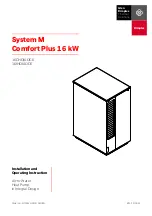
5.1. Suction pipe
When a pump is located above the water level
(suction lift
operation,
fig. 2 A
), fit a foot valve with a strainer, which must
always remain immersed.
The suction pipe must be perfectly airtight and be led upwards
in order to avoid air pockets.
When the liquid level on the suction side is above the pump
(inflow under positive suction head,
fig. 2 B
), fit a gate valve.
Follow local specifications if increasing network pressure.
Install a strainer on the suction side of the pump to prevent
foreign particles from entering the pump.
5.2 Delivery pipe
Install a gate valve in the delivery pipe to regulate flow-rate,
head and absorbed power.
Install a pressure gauge between the pump and the gate valve.
ATTENTION
: install a check valve between the pump and the
gate valve in order to avoid reverse flow after switching off the
pump unit and to protect the pump from water hammering.
With servo-operated shut-off devices, provide an air vessel or
other protection device against surge of pressure in the case of
sudden changes of flow rate.
6. Electrical connection
Electrical connection must be carried out only
by a qualified electrician in accordance with local
regulations.
Follow all safety standards.
The unit must be properly earthed (grounded).
Connect the earthing (grounding) conductor to the terminal with
the marking.
Compare the frequency and mains voltage with the name-plate
motor data and connect the supply conductors to the terminals
in accordance with the corresponding diagram inside the
terminal box.
ATTENTION
: with motor power rating
≥
5.5 kW avoid direct
starting. Provide a control panel with star-delta starting or an
other starting device.
The motors with supply current directly
switched by thermally sensitive switches can
start automatically.
Install a
device for disconnection from the mains
(switch)
with a contact separation of at least 3 mm in all poles.
Install a suitable overload cutout in accordance with the rated
current.
Refer to any other instructions (if supplied) for use of the motor.
7. Starting
7.1. Preliminary checks
Make sure the coupling with the pump shaft turns freely when
rotated by hand (see
section 4.
).
Make sure the screws (64.25) of the coupling are tightened
(see
section 10.2.
).
Make sure the coupling guard (32.30) is fastened
on the lantern bracket.
7.2. Filling
ATTENTION: never run the pump dry, not even for a short
trial run.
Start the pump after filling it completely with liquid.
When the pump is located above the water level
(suction lift
operation,
fig. 2A
) or with a positive suction head which is too
low (less than 1 m) to open the non-return valve, fill the suction
pipe and the pump through the priming hole (
fig. 3
).
To facilitate this operation use a flexible tube (or elbow) and a
funnel.
During filling, the needle screw (14.17) in the drainage plug (14.12)
has to be kept loosened to allow for communication between
the pressure chamber and the suction chamber (
Fig.3a
).
Fig.3a Filling:
Fig.3b Operating:
internal passage open
internal passage closed
When the liquid level on the suction side is above the pump
(inflow under positive suction head,
fig. 2B
), fill the pump by
slowly and completely opening the inflow gate valve while keeping
the delivery gate valve and air vent hole open to release the air.
During filling, keep the air vent hole open only if
the inflowing liquid presents no possible danger
on account of its nature, temperature or pressure.
With a delivery pipe arranged horizontally, or lower than the
pump, keep the delivery gate valve closed during the filling
operation.
7.3. Starting and checking operations
Tighten the needle screw (14.17) in the drainage plug (14.12)
(
fig. 3b
) and close the air vent hole (14.04).
Start the pump with the delivery gate valve closed and with the
suction gate valve fully open. Immediately afterwards, gradually
open the delivery gate valve, adjusting the point of operation
within the limits indicated on the name plate.
With a three-phase motor, check that the direction of rota-
tion is as shown by the arrow on the lantern bracket (32.00):
i.e. clockwise when viewing the motor from the fan end.
Otherwise disconnect electrical power and reverse the connec-
tions of two phases.
3.93.017
5
1
5
1
7
5
4
7
2
5
3
6
B
A
1. Strainer
2. Foot valve
3. Check valve
4. Bypass valve
5. Gate valve
6. Pressure gauge
7. Supports and clamps for
pipelines
Fig. 2 Systems diagram
A = Suction lift operation
B = Positive suction head operation
4.93.007
14.12
14.17
7
Filling and
air vent 14.04
istr_MXV25 01_2010 10-12-2009 8:23 Pagina 7







































